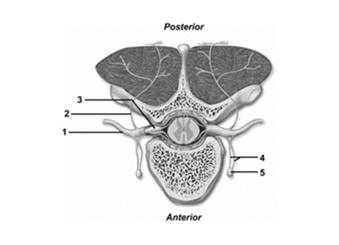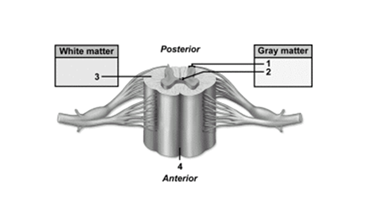A) hypoactive
B) hyperactive
C) diminutive
D) ponderous
E) excessive
Correct Answer

verified
Correct Answer
verified
Multiple Choice
What is the correct order for the events that occur during a reflex A: Impulse travels through sensory neuron to the CNS B: A stimulus activates a receptor C: Information is processed by interneurons D: Motor neuron transmits impulse to effector E: Effector responds
A) a,b,c,d,e
B) b,a,c,d,e
C) c,b,a,e,d
D) c,a,b,d,e
E) b,d,c,a,e
Correct Answer

verified
Correct Answer
verified
True/False
The lateral funiculus contains both ascending and descending tracts.
Correct Answer

verified
Correct Answer
verified
Multiple Choice
Which of the rami is much smaller than the other
A) The anterior ramus
B) The posterior ramus
Correct Answer

verified
B
Correct Answer
verified
Multiple Choice
The posterior ramus of a typical spinal nerve innervates the
A) deep muscles of the back and the skin of the back.
B) major thoracic and abdominal organs.
C) abdominal wall.
D) anterior and lateral trunk and the limbs.
E) special senses.
Correct Answer

verified
Correct Answer
verified
Multiple Choice
Because most pathways decussate,each side of the brain processes information from the _________ side of the body.
A) contralateral
B) ipsilateral
Correct Answer

verified
Correct Answer
verified
Multiple Choice
The third cervical spinal nerve exits the vertebral column through the
A) intervertebral foramen between C2 and C3 vertebrae.
B) intervertebral foramen between C3 and C4 vertebrae.
C) transverse foramen of C3 vertebra.
D) vertebral canal of vertebrae C2,C3,and C4.
Correct Answer

verified
Correct Answer
verified
Multiple Choice
The lateral horns of the spinal cord contain
A) axons of motor neurons and interneuron cell bodies.
B) axons of sensory and motor neurons.
C) cell bodies of somatic sensory neurons.
D) axons of sensory neurons and interneuron cell bodies.
E) cell bodies of autonomic motor neurons.
Correct Answer

verified
Correct Answer
verified
Multiple Choice
Following an injury to his arm,a patient complains that he cannot extend the forearm,wrist,and digits.You suspect that he has damaged the
A) median nerve.
B) radial nerve.
C) musculocutaneous nerve.
D) ulnar nerve.
E) axillary nerve.
Correct Answer

verified
Correct Answer
verified
Multiple Choice
In sum,there are ____ pairs of spinal nerves.
A) 13
B) 31
C) 40
D) 51
E) 12
Correct Answer

verified
Correct Answer
verified
Multiple Choice
If someone steps on a sharp object with their right foot,it will lead to
A) polysynaptic reflexes involving contraction of the right hamstring and left quadriceps.
B) polysynaptic reflexes involving contraction of the right quadriceps and left hamstrings.
C) a monosynaptic reflex causing contraction of the right hamstring and a polysynaptic reflex causing contraction of the left hamstring.
D) a monosynaptic reflex causing contraction of the right quadriceps and a polysynaptic reflex causing contraction of the the left hamstring.
Correct Answer

verified
A
Correct Answer
verified
Multiple Choice
Stepping on a piece of glass would most likely invoke a _____ reflex.
A) Golgi tendon
B) withdrawal
C) stretch
D) pain
E) motor
Correct Answer

verified
Correct Answer
verified
True/False
A pathway has two parts: a bundle of CNS axons and a collection of neuron cell bodies in the CNS.
Correct Answer

verified
Correct Answer
verified
Multiple Choice
The spinal cord part with the largest diameter is the ___________ part.
A) thoracic
B) cervical
C) lumbar
D) sacral
E) coccygeal
Correct Answer

verified
Correct Answer
verified
Multiple Choice
When the Achilles tendon is tapped or the bottom of the foot is stroked,the reflexive response is that the foot
A) plantar flexes.
B) dorsiflexes.
C) inverts.
D) everts.
Correct Answer

verified
A
Correct Answer
verified
Multiple Choice
 -This figure shows spinal nerve branches.What structure does number 1 indicate
-This figure shows spinal nerve branches.What structure does number 1 indicate
A) Anterior ramus
B) Posterior ramus
C) Rami communicantes
D) Sympathetic trunk ganglion
E) Posterior root ganglion
Correct Answer

verified
Correct Answer
verified
Multiple Choice
 -This figure shows a cross section of the spinal cord.What structure does number 2 indicate
-This figure shows a cross section of the spinal cord.What structure does number 2 indicate
A) Lateral horn
B) Anterior horn
C) Gray commissure
D) Posterior horn
E) Posterior funiculus
Correct Answer

verified
Correct Answer
verified
Multiple Choice
Neurons of the thalamus that are part of sensory conduction pathways are considered
A) primary neurons.
B) secondary neurons.
C) tertiary neurons.
D) quaternary neurons.
Correct Answer

verified
Correct Answer
verified
True/False
The alar plate of the embryo develops into the gray commissure of the spinal cord.
Correct Answer

verified
Correct Answer
verified
Multiple Choice
Reflexes are described as
A) slow and spontaneous.
B) spontaneous and self-initiating.
C) pre-programmed and voluntary.
D) rapid and involuntary.
Correct Answer

verified
Correct Answer
verified
Showing 1 - 20 of 130
Related Exams